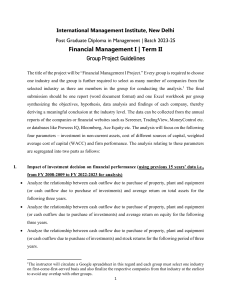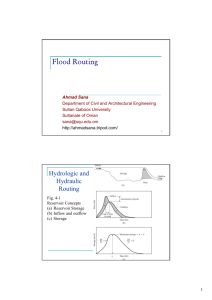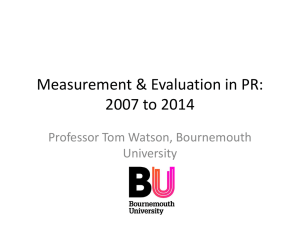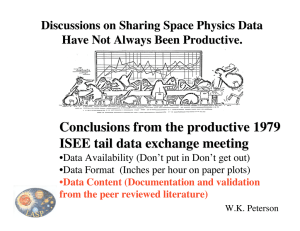Spatial and Temporal Coherence of Ion Outflow W.K. Peterson A. W. Yau
advertisement
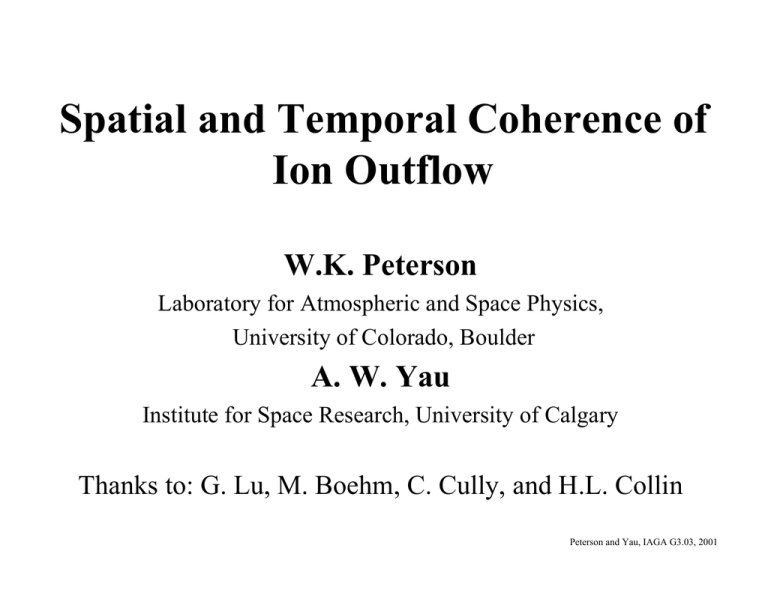
Spatial and Temporal Coherence of Ion Outflow W.K. Peterson Laboratory for Atmospheric and Space Physics, University of Colorado, Boulder A. W. Yau Institute for Space Research, University of Calgary Thanks to: G. Lu, M. Boehm, C. Cully, and H.L. Collin Peterson and Yau, IAGA G3.03, 2001 Why do we care about ion outflow and its spatial/temporal coherence? • Ions contribute significantly to the rigidity of the magnetosphere, especially in the plasma sheet and boundary layer regions • A significant and variable fraction of the ions in the magnetosphere comes from the ionosphere • Travel times for O+ and He+ from the ionosphere to the plasma sheet are of the same order as the time between substorms Is there a long time scale feedback from ion outflow to magnetospheric dynamics? How do we go about proving or disproving such feedback exists? Peterson and Yau, IAGA G3.03, 2001 • It has been difficult to explore the relevance of ionospheric plasmas to long time scale magnetospheric processes because: – Magnetospheric convection and long travel times from the magnetosphere make it difficult to relate events in the ionosphere with events in the plasma sheet and equatorial magnetosphere. – There is very little information available about the spatial and temporal coherence of plasma escape from the ionosphere! • Large scale magnetospheric models can provide a means to identify and quantify feedback, if any, between ionospheric outflow and geomagnetic storms and substorms. – Models would be easier to build and understand if large scale coherent features in ion outflow existed and could be exploited Peterson and Yau, IAGA G3.03, 2001 Hemispherical ion outflow rates as a function of season and species show the association with auroral zone and noon/midnight maxima 6 month sample periods 55o < INVL < 90o 6,000 < Altitude < 8,000 km Polar TIMAS instrument, 15 eV < E/q < 33 keV, 3/96 - 12/98 Peterson and Yau, IAGA G3.03, 2001 There is a seasonal variation in acceleration processes, but the total ion outflow for H+ and O+ is independent of season in the solar minimum Polar/TIMAS data set. Winter He+ is >2x Summer He+ outflow. Left column - Summer Right column - Winter Beams Conics Beams + Conics Total outflow H+ O+ He+ Peterson and Yau, IAGA G3.03, 2001 A small fraction of upwelling thermal plasma from the collision dominated F region (above ~300km) can escape. Abe and coworkers have shown the polar wind is strongly modulated by sunlight The seasonal independence of H+ and O+ outflow rates during solar minimum conditions observed by Polar/TIMAS suggests that 1) Outflow rates are set by conditions in the ionosphere 2) The energy of outflowing ions is set by auroral energization and acceleration processes acting above 300 km. This suggests that there might be some large scale spatial and temporal coherence in ion outflow that modelers can exploit How coherent is ion outflow? 3 hour bins for KP 1 hour bins for AE 18 month sample period From analysis of almost a solar cycle’s worth of DE -1 mass spectrometer data Yau et al., [1988] found that a power index (AE, KP, DST) and a solar EUV index [F10.7] characterized global ion outflow. Peterson and Yau, IAGA G3.03, 2001 What do we know about spatial and temporal variations of ion outflow? • Temporal Variation – Clearly resolved seasonal variation in He+ outflow – Clearly resolved variation in 18 month average global outflow rates with magnetic and solar activity dependence captured in the DE 1 empirical models • Spatial Variation – Outflow is closely associated with the Auroral Zone. – There are clearly defined maxima in outflow for Cusp/Cleft and Midnight MLT Regions • Almost no information is available on temporal variations on time scales less than a season. • Some information is available on the simultaneous spatial and temporal variations (coherence) of ion outflow. Peterson and Yau, IAGA G3.03, 2001 Stevenson et al. (to appear in JGR, 2001) have shown a strong correlation between UV emissions and upflowing O+ for three perigee passes of the Polar satellite. Circles enclose individual images from the Polar UVI instrument Vectors show O+ velocity measured by the Polar/TIDE instrument. Demonstrates the spatial association of outflow with electron precipitation Peterson and Yau, IAGA G3.03, 2001 Wilson et al. [to appear in JGR] have looked at outflowing O+ from FAST in association with POLAR UV images for ~50 FAST orbits in January and February 1997. Solid line - O+ upflowing flux Dotted line - 5 image frame average of LBHL intensity (170 nm) Note the time offset between emissions and O+ Fits of O+ outflow to time lagged image intensity have relatively poor correlation coefficients Solid line - 19 FAST orbits from February 7-11, 1997 Implied O+ velocity 5 km/s = 2eV Dashed line - 31 FAST orbits from January 25-31, 1997 Implied O+ velocity 13 km/s =15eV Demonstrates the variable nature of time of flight effects. From Wilson et al., 2001. Peterson and Yau, IAGA G3.03, 2001 Valek et al. 2001., have looked at properties of escaping O+ as a function of location relative to the equatorward edge of the polar cusp using an automated procedure applied to data from the Polar/TIDE instrument acquired at perigee O + H TIDE E-T TIDE A-T e - They found, as have others, that the cusp position moves as a function of IMF direction and magnetic activity + Valek et al. 2001. found: Upflow velocity T parallel T perp O+ upflow begins at equatorward edge of cusp independent of IMF direction O+ upflowing plasma is hotter poleward of the cusp for IMF northward Density O+ Density and outflow rate from cusp region are larger Normalized cusp position for IMF southward for IMF northward and southward Peterson and Yau, IAGA G3.03, 2001 Tung et al. (JGR, 2001) found enhanced H+ outflow associated with conics near midnight in the recovery phase of substorms. The observed fluxes, over limited MLT range can account for a small (<10 %) fraction of the plasma sheet ion population Distribution of events in MLT for Jan/Feb ‘97 Peterson and Yau, IAGA G3.03, 2001 Question: • Is ion outflow proportional to solar wind power input over extensive or limited spatial scales? – Can global ion outflow be characterized instantaneously by a single parameter? There are currently six operating satellites with mass spectrometers capable of monitoring ion outflow Akebono/SMS (1989-), Polar/TIMAS(1996-), and FAST/TEAMS (1996-), 3 Cluster satellites (2000-) Peterson and Yau, IAGA G3.03, 2001 Table 1: Orbit, Instrument, and Data parameters Energy Range Altitude Range Inclination Data interval Akebono 0-70 eV 275 10,500 km 75 o 8-16 s Polar 15 eV 33 keV 29 Re/R 90 o 192 s a 12 s b Data samples Total 916 1725 c Cusp 0% 8% d Polar Cap 37% 63% Upward O+ 85% 71% + H 50% 71% a Apogee b Perigee c 09-15 MLT b Invl > 75o ; outside of cusp MLT range FAST 1 eV 12 keV 400 4000 km 83 o 5 - 20 s 7306 31% 34% The first time three satellites were operating during a geomagnetic event, and subsequent quiet interval, was in January, 1997 48% 16% Peterson et al. (unpublished manuscript)have reported the lack of spatial or temporal coherence of H+ and O+ outflow during the period January 9-12, 1997. Peterson and Yau, IAGA G3.03, 2001 January 9-12, 1997 Upward O+ fluxes observed by Akebono, FAST, and Polar normalized to 300 km. Peterson and Yau, IAGA G3.03, 2001 FAST, Akebono, and Polar (note change in colors) Interval is mostly quiet with periods of activity at various levels No magnetic conjunctions during this interval. AE Akebono did not sample the cusp region Significant data gaps in Akebono and FAST data Peterson and Yau, IAGA G3.03, 2001 Ion outflow (m-2-s -1) Vs AE AE calculated from 68 magnetometers at 5 minute resolution. Absolute values show lower fluxes at FAST as expected. Scatter of data points at all levels of activity and all locations is very large! Green lines are expected outflow from Yau et al., 1988 Peterson and Yau, IAGA G3.03, 2001 Plotting the data in log-log format shows the observed dependence on AE is consistent with the Yau et al. prediction, but ....they are also consistent with many other exponents! Green lines are expected outflow from Yau et al., 1988 Peterson and Yau, IAGA G3.03, 2001 We have also considered: • Outflow from specific source regions • cusp, polar cap, auroral zone • Time delay from 300 km to observation point of: • 1, 10, 100 km/s • no time delay We have found no better fits (i.e. correlation) in any of these Yau et al., 1988 subsets of the data. Why do we see so much more scatter in this data set than in the 18 month average data set from DE 1 reported by Yau et al. Peterson and Yau, IAGA G3.03, 2001 The Aurora, and therefore upflowing ions are dynamic in space and time. • There are large scale features of the aurora that are commonly seen in long term average satellite data. – Such as the Feldstein auroral oval and Ijima and Potemra field aligned current patterns. • These large scale features are not generally seen in high time resolution data because auroral arcs are essentially narrow filaments that, on average, fill the auroral oval. Peterson and Yau, IAGA G3.03, 2001 • Yau et al. examine average fluxes in INVL/MLT/ALT bins accumulated over 18 month accumulation intervals Vs. 3 hr KP and 1 hr AE and DST indices. They found large scale features. • Our data set used instantaneous measurements from large regions (cusp, polar cap, auroral zone) Vs. 5 minute AE index. We did not find the coherence reported by Yau et al. • Casting the outflow data in boundary oriented coordinates (i.e. relative to the polar cap boundary) will improve the correlation. – Such an effort is expensive. – Funds have been requested for the analysis. Peterson and Yau, IAGA G3.03, 2001 Conclusions (1): • Global Ion outflow has been shown to be – Constant by season at solar minimum (no data for solar max) – Coherent in 18 month bins • Magnetic activity parameterized by AE • Solar activity parameterized by F10.7 – Not coherent (i.e. organized) in one day bins by a single parameter such as AE on day time scales. • There is a suggestion that if the outflow data were in boundary oriented coordinates, outflow from selected regions might be organized by a parameter such as AE on day time scales. Peterson and Yau, IAGA G3.03, 2001 Conclusions (2): • Global Ion outflow has been shown to – Have seasonal variations in energy and angular distributions – Be spatially organized by • Magnetospheric region (cusp, az, polar cap etc.) • Local Time • Auroral arcs visible in EUV – i.e. electron precipitation regions. – Have intense impulses of outflowing H+ in the midnight region associated with substorms. – Have slightly more O+ outflowing from the cusp region during intervals of southward IMF. Peterson and Yau, IAGA G3.03, 2001 Conclusions (3): • Localized Ion outflow has been shown to – Have spatial and temporal variations comparable to variations in the intensity of precipitating electrons • Finally: Finally – We have shown here that there is no quick and dirty way to parameterize global ion outflow instantaneously using a single parameter such as AE. • Inclusion of ion outflow effects in large scale models will require some way to account for (parameterize) the spatial and temporal variability. – Possibilities include organizing ion outflow data in field-aligned or boundary based coordinate systems. Peterson and Yau, IAGA G3.03, 2001
